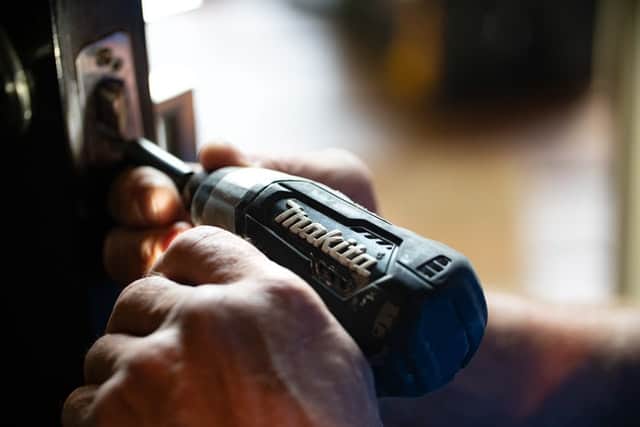
With so many cordless drills on the market, it is difficult to know which one is right for you. Choosing the right one is easy once you understand the subtle differences and what makes them unique. The choice honestly might be as simple as “this cordless drill uses the same battery as some of your other tools,” which is a completely valid reason.
Deciding which cordless drill to purchase comes down to what jobs you will be needing it for. First, decide between a drill driver or an impact drill before selecting the desired voltage, or power output. Next, shop around for the best price or wait until a holiday sale. If you’re still not sure which one to choose, head to your local hardware store and test various models out!
For those with a more difficult decision, let’s explore the world of the cordless drill! Armed with the right knowledge, you’ll find the perfect cordless drill for all your drilling needs.
The Two Main Types of Cordless Drill
Without considering drills primarily used in construction, there are two main types of cordless drills for home use: the drill driver and the impact drill. In all fairness, each of these tools has their own pros and cons and are best utilized together for specific jobs, but we’ll break down each to get a feel for when and where to use them.
Drill Driver
The drill driver is the most basic and versatile of the two and is the tool most commonly thought of when thinking of a “drill.” These tools contain a “chuck” with teeth that close around a bit and, in some cases, an adjustable power output mechanism that can adjust the speed and torque of the drill.
These tools rotate clockwise (tighten or drive in) and counterclockwise (loosen or pull out) and that’s about it, but are the preferred drill for drilling into soft materials like most woods, drywall/sheetrock, and tiles and ceramics due to the increased control when using them.
Drill drivers are perfect for your basic weekend warrior or novice-to-intermediate do-it-yourselfer, or as a compliment to the next tool.
Impact Drill
My personal drill of choice, the impact drill adds exactly that, a downward impacting force in addition to the rotational torque. The added versatility makes them a “jack of all trades” drill, and you can quite literally utilize them in all projects and situations, no matter how big or small.
The additional impact makes them ideal for drilling into harder materials like hardwoods and cement slabs, while some even come with the ability to turn the impact feature off, returning them to a drill driver.
Cordless Drill Voltage
The voltage of a drill is quite simply the amount of power output transferred from the electric battery, through the motor, and transformed into torque (the strength of rotation). The higher the voltage, the more torque and drilling power the drill will put out.
Smaller cordless drills typically operate in the 6.0 to 7.2V range, which is ideal for small, general tasks around the house like hanging pictures, changing door handles, installing pulls or knobs on cabinetry, etc. The small size also makes them highly portable and able to fit in tighter spaces. Just don’t be counting on them for a lot of power!
Moderate cordless drills, those in the 9.6 to 12V range, will handle most remodeling work around the house. From drilling through most woods and drilling pilot holes to working on decking outside, drills in this range should have you covered for anything around the house.
For cement drilling and drilling through metal or pressure-treated wood, it is best to step it up to the high voltage drills, which typically fall between 14.4 and 18V. Realize the trade off here is a bigger size and additional weight, but these drills can tackle just about anything.
Shop Around For The Best Price
Once you have narrowed down your selections to fit your particular needs, shop around for the best price on a few similar models. Compare prices online from your local hardware stores against bulk online retailers like Amazon. We try hard to save you valuable time and money with all of our projects here at Drill Warrior, and this is no different!
Read reviews online of the models you are thinking about purchasing before pulling the trigger. A good way to approach reviews online is to look at the aggregate average ratings. I also like to read the low rating posts to get a sense for where the shortcomings are for a given item to be purchased. This helps you see if any compromises need to be made, where they need to be made, and makes it easy to compare pros and cons from the consumers themselves.
Still Can’t Make A Decision? Test Drills Out!
Local hardware stores keep various models of cordless drills out for consumers to test out in the store. The exact models you test is less important than getting a feel for the difference between things like drill drivers vs. impact drills and various voltages.
Feel the difference in torque an additional four volts makes and decide if that is something you need (because it will cost you a little extra!). See the difference in both feel and performance between drill drivers and impact drills and weigh the new findings against your needs at home.
Drill Purchasing Roadmap
Breaking a larger decision down into manageable chunks – a roadmap, if you will – will help you reach the best conclusions. Start by focusing your thoughts on what you need the cordless drill for. Let those requirements narrow your choices down by necessity first, starting with drill driver vs. impact. Next, think about how much power you will need out of your cordless drill to further narrow down available choices.
Once you have narrowed down the choices by necessity, do some research on pricing and reviews to narrow down the available pool of choices further. Pay particular attention to the negative reviews online to gauge the cons from each model. If you still can’t decide, head into your local hardware store and get a little hands-on time with various drills to find the one that suits your needs.
Just as with any project covered here at Drill Warrior, we want you to be as prepared as you possibly can when picking out your brand new cordless drill.
Other Considerations
I personally like to have no fewer than two batteries for my cordless power tools so I’m never losing work time for the thing to charge. I can swap the drained battery out for the fully charged one and by the time I need a new battery, I can grab the one I swapped out with.
Consider how many batteries each cordless drill comes with. Also consider purchasing one that uses the same battery packs of some of your other tools, which makes charging even easier.
Although mostly a thing of the past, some drills still require a key to loosen and tighten the chucks. Most cordless drills on the market today can be loosened and tightened by hand without a keyed chuck, but that is definitely something worth paying attention to if you need to be changing bits out regularly.
Some cordless drills come with built in lights, which helps illuminate your work area in tight, dark places. Most new models have this feature.
Some cordless drills also come with a built in level. I’ve used one with a built in level and found I preferred the precision of a standard level. The base of the drill is simply too small to get an accurate reading.
Although rare, some cordless drills don’t come with a battery and/or a battery charging dock. Pay close attention to the box so you don’t buy something thinking it is all-inclusive when the reality is the unit comes with far less accessories than you originally thought.
Finally, holding units in your hand allows you to get a good feel for the weight and balance of various cordless drills. Some are very top-heavy and topple over easily, so pay attention to how it sits if that is something that is important to you.

